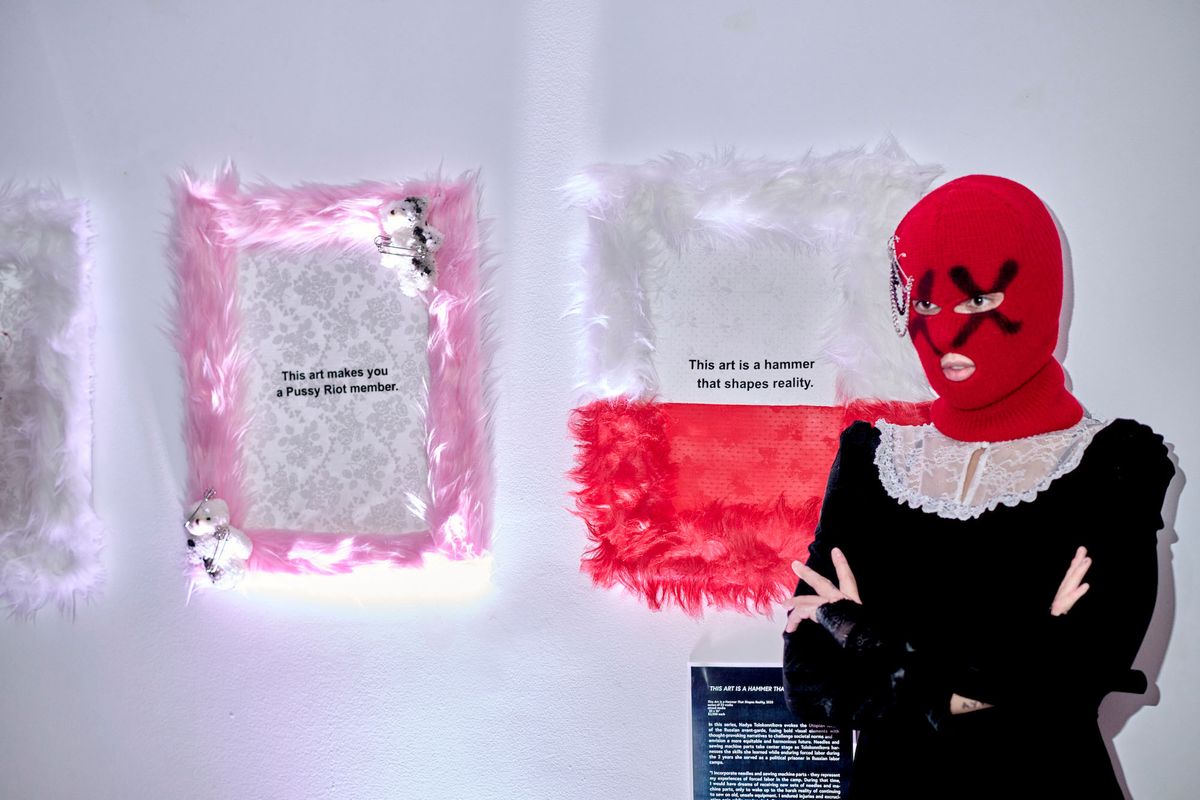On the wall is a photo showing Nadya Tolokonnikova, one of the creators of the Russian feminist protest art collective Pussy Riot, in a blue prison uniform, seated at a small desk, with a bare wooden board to her right. The wall is that of a small room, an almost exact reproduction of the prison cell in Siberia where the artist spent two years in solitary confinement. The room is at the end of a hall lit bright red, with red paint splattered on the floor to resemble blood. It’s the final scene visitors encounter in Tolokonnikova’s exhibition at Container in Santa Fe, Putin’s Ashes (until 20 July).
The exhibition spans two floors, includes many works made in recent months and takes visitors on a journey through the traumas and violence Tolokonnikova suffered due to her activism against Russian president Vladimir Putin’s regime. The artist guides me, by way of her phone’s camera, through what she calls a “total installation”, a reference to the view of late Ukrainian American artist Ilya Kabakov that conceptual artists should be in charge of the context of their exhibitions, including the spaces between the artworks.

Installation view of Pussy Riot/Nadya Tolokonnikova: Putin's Ashes at Container, Santa Fe, New Mexico Photo by Molly O'Brien
Pussy Riot formed in 2011, with a loud punk aesthetic framing the performances staged by the group. Initially an all-women and female-identifying collective, Pussy Riot has evolved into a global movement with hundreds of members of all genders. This exhibition shares the same title as a Pussy Riot performance staged earlier this year, in which a group of women in balaclavas burned an effigy of the Russian president. The ashes retrieved from that performance were collected in small glass flasks of different sizes that are now part of the installation. Along with them, there are buttons on the wall that, if pushed, promise to turn Putin into ashes and eliminate sexism.
The space is part white cube, part street protest, with paint-splattered barrels placed throughout and graffiti on the walls. Near the entrance are plush-framed panels featuring phrases such as “this art is too political” or “this art is created by a criminal”. Some of them are splashed with red paint to evoke blood, some have sewing machine parts attached to them.
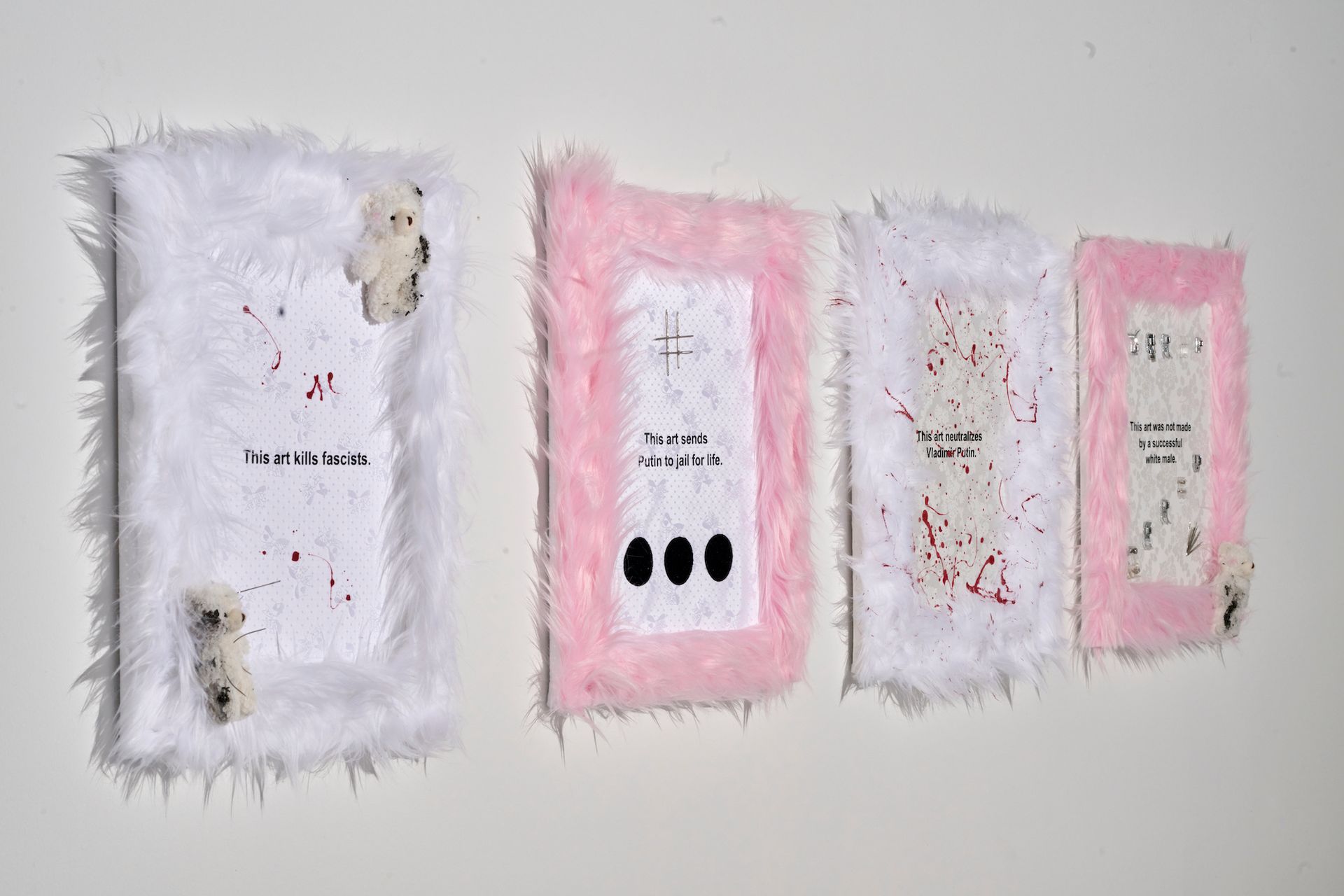
Installation view of Pussy Riot/Nadya Tolokonnikova: Putin's Ashes at Container, Santa Fe, New Mexico Photo by Molly O'Brien
During her nearly two years’ detention in Russian penal colonies, Tolokonnikova had to sew military uniforms using old machines with often-broken components that injured her fingers. “At night, I would dream that I'd get new sets of needles and parts of sewing machines,” she says. “In reality you never had enough and you had to injure yourself while sewing. So this is my blood.” Incarcerated women were typically required to work between eight and 16 hours each day. “They had me work less than other prisoners because I had lawyers and stuff, but I still had to fulfill the same quota, so I had to be very focused.”
In a hallway at Container, a series of screens shows what the artist calls Pussy Riot’s “legacy videos”, recordings of the performances that brought the group global attention. They include footage of a recent performance in front of the prison in which the opposition leader Alexei Navalny is detained, and Punk Prayer, the 2012 performance in Moscow’s Cathedral of Christ the Saviour that earned Tolokonnikova and two other activists of the group prison sentences. The wall along the staircase to the gallery’s second floor might look like something out of a nightclub, but the pink squares that decorate it frame knives like those made in prison with makeshift materials, as improvised weapons of self-protection. These were forged from metal recovered from an abandoned prison and are shaped in a distinctive Pussy Riot style into symbols of women’s power.
Alongside the centrepiece of the show, a fall-filing projection of the short film documenting the Putin’s Ashes performance, there are posters featuring lyrics from Pussy Riot’s first song, Kill the Sexist, and text from Tolokonnikova’s court sentence. Atop the texts are drawings of a vagina-shaped Virgin Mary figure, which the artist says resulted in her being added to Russia’s list of wanted criminals. In the centre of the room is a sculpture featuring a dollhouse, HAUNTED! (2023), whose façade and interiors are covered in pills and orange pill bottles crawling over every surface like invasive species. The pill bottles are for duloxetine, Tolokonnikova says, “the medication I have to take ever since I got out of jail because I was diagnosed with PTSD and depression. I hate these pills and am trying to get off them. But they keep coming back to my life. And it’s always a struggle.” The work is accompanied by a soundscape and poetry created by Bono of U2. One passage states, “I turned my rage into beauty and my beauty into rage.”

Nadya Tolokonnikova, HAUNTED!, 2023 Photo courtesy the artist
Though Pussy Riot’s art directly engages with Russian politics, some of the topics the show at Container deals with are relevant to other countries as well. “Since Pussy Riot’s inception, we have always wanted to be universal and global,” Tolokonnikova says. “I love to call it alter-globalist because I believe that we need coordination on a global level to achieve our goals as humanity. Otherwise, global poverty, mental health, financial inequality and wars are not going to be solved. We’re not doing a good job on that. I believe that collectives like Pussy Riot, or Zapatistas in Chiapas, Mexico, or Extinction Rebellion, with their global support base, are important to counteract the bad players, such as transnational corporations or authoritarian governments.”
Since the imprisonment of three of their members, one of the focus areas for Pussy Riot has become incarceration and prison reform. During a previous visit to the US, Tolokonnikova and other members of the group made clear that this was a priority. “We met the then mayor of New York, Bill de Blasio, and he asked us, ‘How can I help you?’” she says. “We said, ‘We want to go to jail.’ He was like, ‘You just got out of jail,’ and we said, ‘No, we want to go to Rikers.’ We wanted to see the conditions there.”
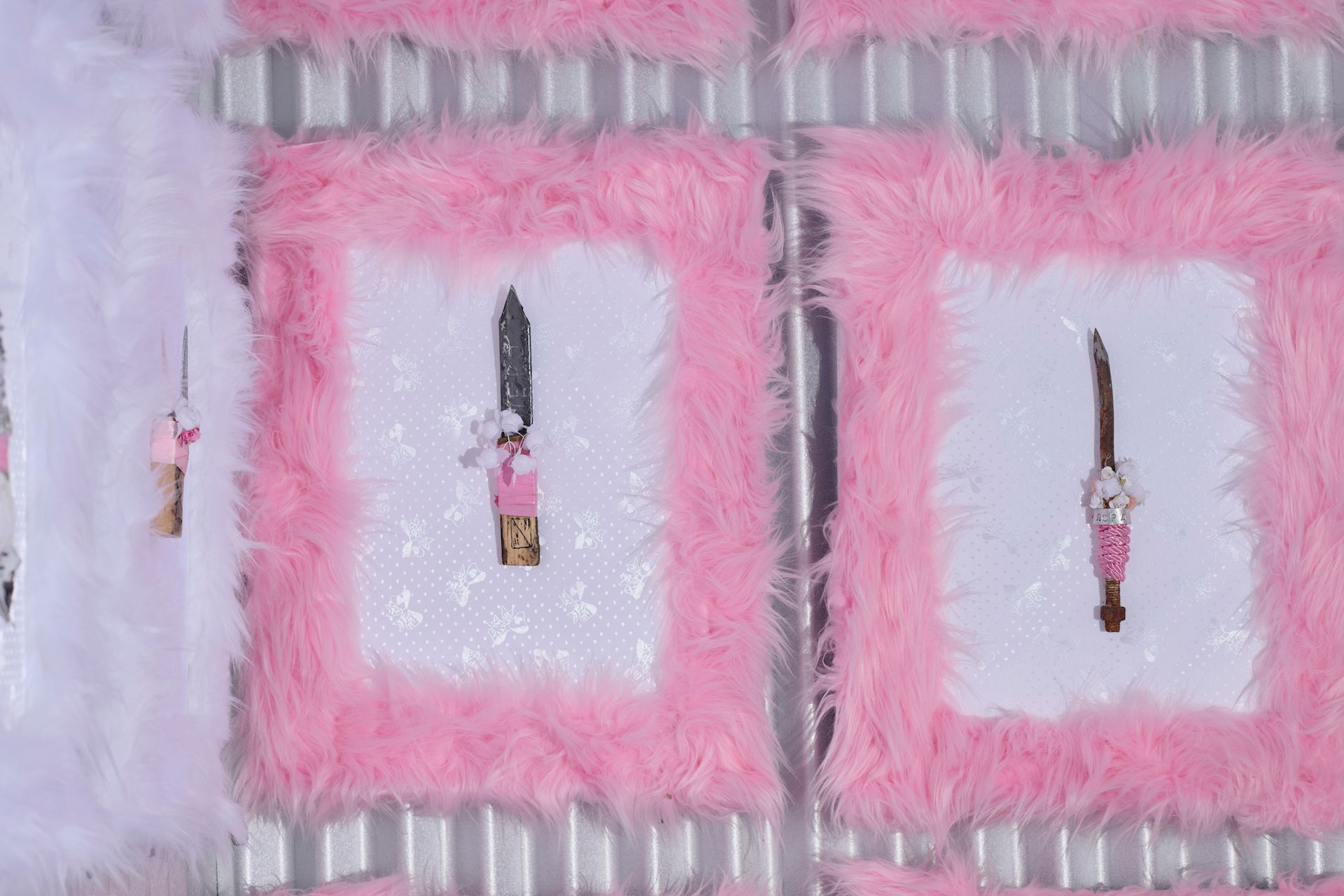
Installation view of Pussy Riot/Nadya Tolokonnikova: Putin's Ashes at Container, Santa Fe, New Mexico Photo by Molly O'Brien
The mayor's office organised a visit to the infamous Rikers Island jail complex, which activists have been calling on city to shut down for years. Pussy Riot members toured the facility and talked to incarcerated people but took the experience with a grain of salt. “Officially organised visits are not real, so then we spoke with people who went through Rikers and we connected with groups working on rehabilitation through art,” says Tolokonnikova. “My interest continues. I visited prison facilities in downtown Los Angeles, I got to try the food—which was absolutely horrible. I got to see how they treat mentally ill people: they chained them to the table. There's so much to address. And the fact that the prison population per capita in the United States is the biggest in the world while the country claims to be the land of the free is just sad.”
A corridor marked by red lights leads to the prison cell, where the exhibition ends. Tolokonnikova was there on opening day, welcoming visitors to Container and to the replica of her cell. She says she will not hire a bodyguard—as her friend, artist Judy Chicago, keeps recommending—because in her view if her government really wants to poison her with a military-grade nerve agent, having a guard will make little different.
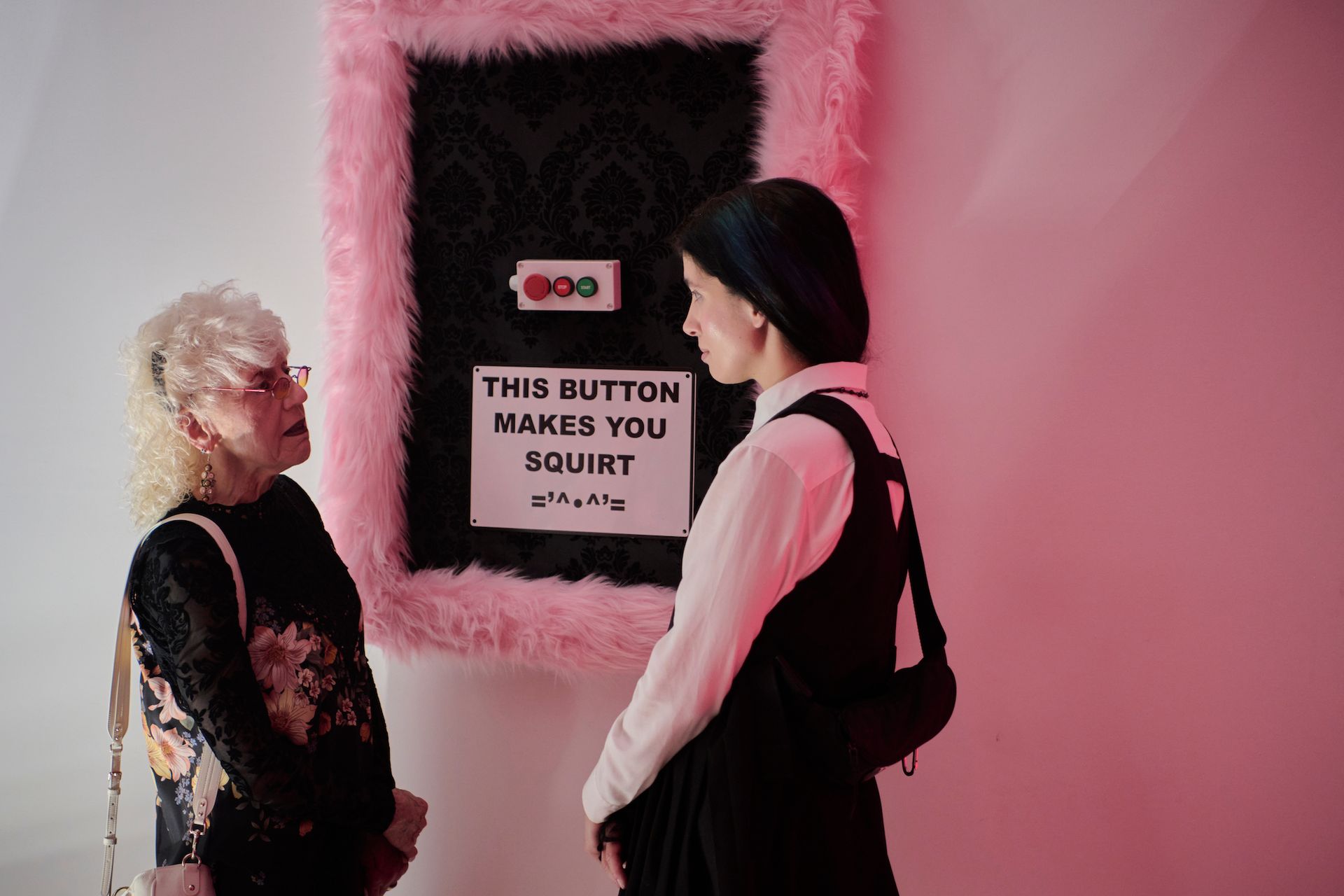
Judy Chicago (left) and Nadya Tolokonnikova (right) at the opening of Putin's Ashes at Container, Santa Fe, New Mexico Photo by Molly O'Brien
“When I got out of prison in early 2014, I couldn’t recognise my country,” she says. “It was much darker, censorship was stronger and people were more afraid. And then [Russia’s annexation of] Crimea happened and it was really the beginning of the end.”
Since Russia’s full-scale invasion of Ukraine began in February 2022, the artist has felt an ever-stronger need to act. She has been collaborating with Ukrainians who she says are less scared than Russians and have been an inspiration for her since the country’s first Orange Revolution began, in 2004. And while she concedes that there are some Ukrainians for whom “the only good Russian is a dead Russian”, she says there are also many who are willing to collaborate with her. For the exhibition at Container, Tolokonnikova relied on the help of Ukrainian producerVal Zabaluyev, and she says about 40% of the women who took part in the Putin’s Ashes performance were from Ukraine; some of them had recently fled the country because of the war.
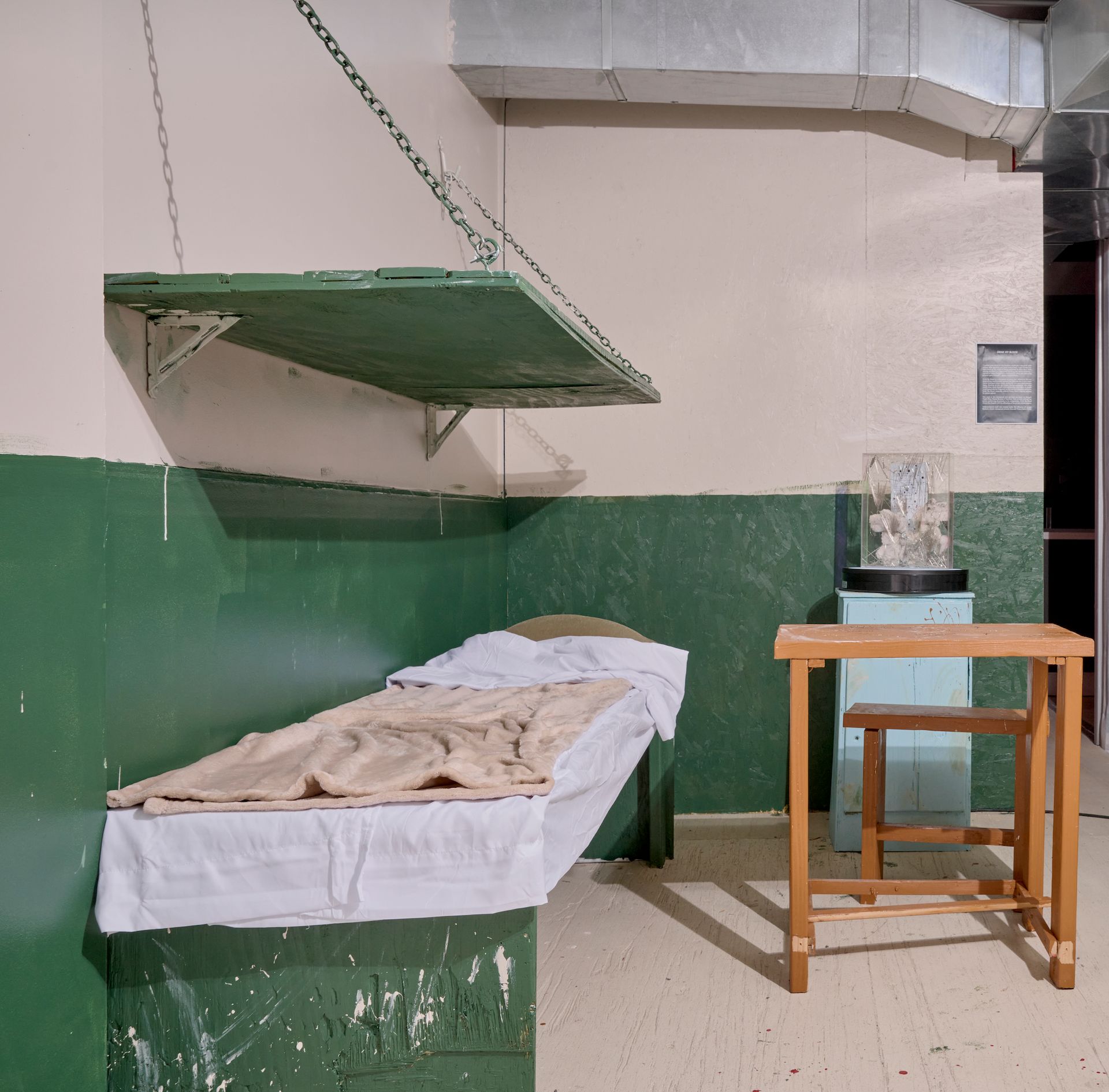
Installation view of Pussy Riot/Nadya Tolokonnikova: Putin's Ashes featuring a re-creation of Tolokonnikova's penal colony cell at Container, Santa Fe, New Mexico Photo by Molly O'Brien
“I still believe that art can be more powerful than tanks and bullets sometimes because bullets can only penetrate your body, art can penetrate your mind,” Tolokonnikova says. “So my art follows the phrase: this art is a weapon.”
- Pussy Riot/Nadya Tolokonnikova: Putin’s Ashes, until 20 July, Container, Santa Fe, New Mexico


